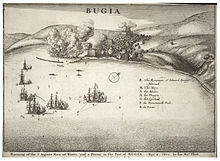HMS Advice (1650)
| History | |
|---|---|
| Name | HMS Advice |
| Builder | Peter Pett II, Woodbridge |
| Launched | 1650 |
| Captured | 27 June 1711, by French privateers |
| Acquired | 27 June 1711 |
| General characteristics as built[1] | |
| Class and type | Fourth-rate frigate |
| Tons burthen | 51664⁄94 (bm) |
| Length | 100 ft (30.5 m) (keel) |
| Beam | 31 ft 2 in (9.5 m) |
| Depth of hold | 12 ft 3 in (3.7 m) |
| Propulsion | Sails |
| Sail plan | Full-rigged ship |
| Armament | 40 guns (1660); 48 guns (1677) |
| General characteristics after 1698 rebuild[2] | |
| Class and type | 46-54-gun fourth-rate ship of the line |
| Tons burthen | 551 long tons (559.8 t) |
| Length | 118 ft (36.0 m) (gundeck) |
| Beam | 32 ft 4 in (9.9 m) |
| Depth of hold | 12 ft 1 in (3.7 m) |
| Propulsion | Sails |
| Sail plan | Full-rigged ship |
| Armament | 46-54 guns of various weights of shot |
HMS Advice was a 40-gun fourth-rate frigate, built for the Commonwealth of England and transferring to the Royal Navy upon Britain's restoration of the monarchy in 1660.
By 1677 her armament had been increased to 48 guns.[1]
Construction[]
Advice was one of six frigates ordered by the Commonwealth of England in 1649. Her design was proposed to be modeled on that of two 1647 vessels then in active service, HMS Elizabeth and HMS Phoenix. On 4 January 1650, the Admiralty Committee reached agreement with master shipwright Peter Pett to construct the vessel under private contract at Woodbridge docks, for a fee of £6.10d a ton. Initial plans were for a vessel of 34 guns with a 100 ft (30 m) keel and 31 ft (9.4 m) beam, measuring 511 16⁄94 tons burthen. Her crew complement was set at 150 men.[3]
Construction commenced in early 1650. As built, Advice measured 118 ft 6 in (36.12 m) over the agreed 100 foot keel, with a hold depth of 15 ft 7 in (4.75 m). her final measurement slightly exceeded the contracted amount, at 516 64⁄94 tons burthen. The Admiralty fee for the vessel split the difference between the contract amount and the final size, paying £6.10d a ton on 513 tons for a total purchase price of £3,334.10d. The frigate was formally named Advice on 16 August 1650.[3]
[]
First Anglo Dutch War[]
Active was commissioned by the Commonwealth in late 1650, for service off the west coast of England. Her first captain, George Dakins, served aboard until the end of 1652, when he was succeeded by John Day. In early 1653 Advice was formally attached to the British fleet under Admiral Robert Blake for service in the First Anglo-Dutch War, and was involved in most major sea battles of the conflict, commencing with the inconclusive Battle of Portland in February 1653.[3]
By mid-1653 Captain Day had been replaced by Captain Jeremiah Smith, who was in command when Advice sailed as part of Blake's reinforcement of the British fleet at the Battle of the Gabbard on 3 June. Advice was assigned to the Centre Division of Britain's Red Squadron under the direct control of General-at-Sea George Monck. In this position she joined the line of battle against the Dutch fleet but is not recorded to have suffered damage from enemy fire.[3]
Advice was not present at the final major naval engagement of the War, the Battle of Scheveningen in July 1653. Late in that year her command transferred from Jeremiah Smith to Captain Francis Allen. After Scheveningen the Dutch Navy no longer sought direct engagement with the British at sea. Advice was instead assigned to patrolling the Dutch shoreline to interfere with merchant shipping.[3] She held this station over the winter of 1653 and into the new year;[3] the War itself ended four months later with the Treaty of Westminster in July 1654.

Later service[]
She underwent a rebuild in 1698 at Woolwich Dockyard, from where she was relaunched as a fourth-rate ship of the line of between 46 and 54 guns.[2] On 27 June 1711, while lying in Yarmouth Roads, Advice was attacked by five privateers flying French colours. The French ships lay off Advice's quarter, relieving each other as necessary, and caused a great deal of damage to the sails and rigging. Despite their resistance, Captain Lord Duffus was forced to surrender after two thirds of his crew had been killed or wounded, and he having taken a total of five musket balls to various parts of his body. The privateers took Advice back to Dunkirk.[4]
Notes[]
References[]
- Lavery, Brian (2003). The Ship of the Line, Volume 1:The Development of the Battle Fleet 1650-1850. Conway Maritime Press. ISBN 0851772528.
- "Michael Phillips' Ships of the Old Navy: Advice". Michael Phillips. 2007. Retrieved 6 January 2015.
- Winfield, Rif (2009). British Warships of the Age of Sail 1603–1714: Design, Construction, Careers and Fates. Seaforth. ISBN 9781848320406.
- Ships of the line of the Royal Navy
- Ships built in England
- 1650s ships